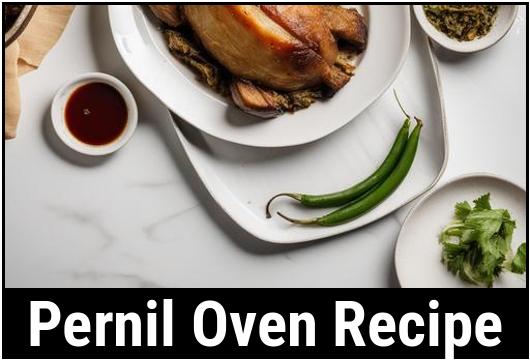
Pernil Oven Recipe: The Ultimate Guide To Perfectly Succulent Pork Roast
Why Pernil?
Pernil, a popular Puerto Rican dish, is a succulent, slow-roasted pork shoulder that is marinated and cooked to perfection. The flavors are deeply infused into the meat, resulting in a tender and flavorful roast that will leave your taste buds dancing with joy. In this comprehensive guide, we will delve into the food science, culinary details, selection, cleaning, preparation, tips, variations, doneness checks, recipe, and even address the potential pitfalls of overcooking or undercooking. So buckle up and get ready to explore the world of pernil!
Food Science of Pernil
To better understand the process of cooking pernil, it’s essential to have a basic understanding of the food science behind it. Pork shoulder, or pernil, is rich in connective tissue and fat. When cooked slowly at a low temperature, these tough cuts of meat transform into flavorful, succulent dishes. The collagen in the connective tissues breaks down over time, resulting in tender meat that falls off the bone with each bite.
Selecting the Perfect Pork Shoulder
Choosing the Cut
When selecting a pork shoulder for pernil, opt for a bone-in, skin-on cut. The bone adds flavor, while the skin adds a delightful crispy texture to the final dish. Aim for a shoulder between 5 to 7 pounds, as this size is perfect for feeding a crowd without compromising on tenderness.
Evaluating Freshness
Inspect the meat for a vibrant pink color, signifying freshness. Additionally, ensure that the meat is moist but not excessively wet. Avoid cuts with any off odors, as this may indicate spoilage. Freshness is key to achieving the best results when cooking pernil.
Cleaning and Preparing the Pork Shoulder
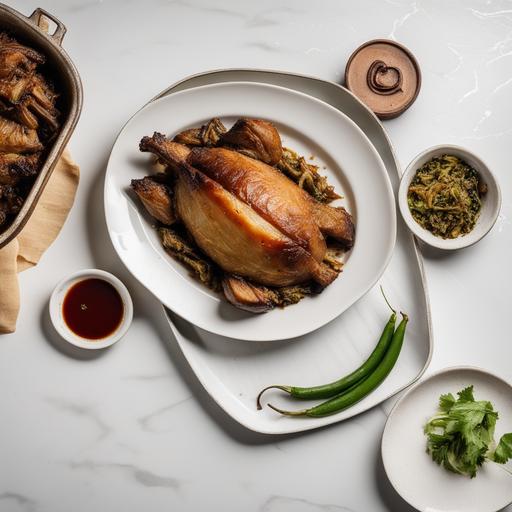
Prepping the Meat
Before marinating the meat, it’s crucial to ensure it is clean and ready for seasoning. Start by rinsing the pork shoulder under cold running water to wash away any unwanted debris. Pat the meat dry with paper towels to remove excess moisture, as this will help the seasonings adhere better.
Score the Skin
Using a sharp knife, make shallow, crisscross cuts across the skin. This process, known as scoring, allows the flavors to penetrate the meat while rendering the skin crispy during cooking. Ensure the cuts are evenly spaced, approximately 1 inch apart, to ensure uniform cooking.
Marinating the Pernil
The key to achieving a flavorful pernil lies in the marinade. Prepare a marinade using a combination of citrus juices, herbs, spices, and aromatics. Mix ingredients such as orange juice, lime juice, garlic, oregano, cumin, and adobo seasoning in a bowl. Place the pork shoulder in a large resealable bag, pour the marinade over it, and seal tightly. Massage the marinade into the meat, ensuring every inch is coated. Refrigerate the pork shoulder for at least 24 hours, allowing the flavors to meld and intensify.
Tips and Tricks for Perfect Pernil
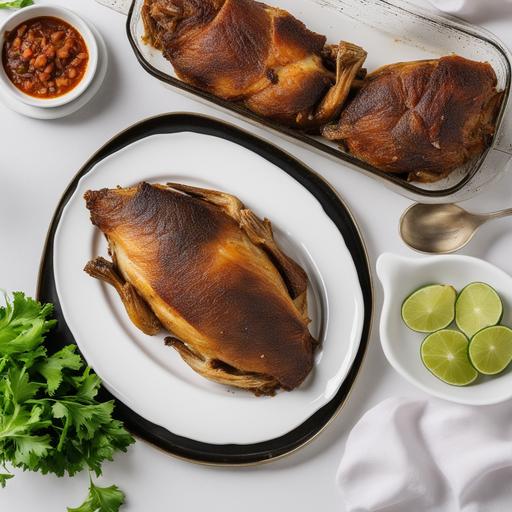
Slow and Low Cooking
Achieving tender, juicy pernil requires slow and low cooking. Preheat your oven to 325°F (165°C). Place the marinated pork shoulder, along with the marinade, into a large roasting pan or Dutch oven with a tight-fitting lid. Cover the pan tightly and allow the meat to cook undisturbed for several hours. Slow cooking allows the connective tissues in the pork shoulder to break down, resulting in a melt-in-your-mouth texture.
Basting for Moisture
Throughout the cooking process, basting the pernil with its own juices is crucial. Every hour, uncover the pan and use a baster or spoon to drizzle the pan juices over the roast. This adds moisture, enhances flavor, and helps achieve a beautiful caramelized exterior.
Crispy Skin
If you desire a crispy skin, there is an additional step to follow. About 30 minutes before the cooking time is complete, increase the oven temperature to 425°F (218°C). This high heat will render the skin crispy and irresistible. Keep a close eye on the pernil during this step to prevent it from burning.
Resting Period
Once the pernil has finished cooking, remove it from the oven, tent it loosely with aluminum foil, and allow it to rest for about 20 minutes. This resting period allows the juices to redistribute throughout the meat, ensuring an even distribution of flavor and tenderness.
Variations to Explore
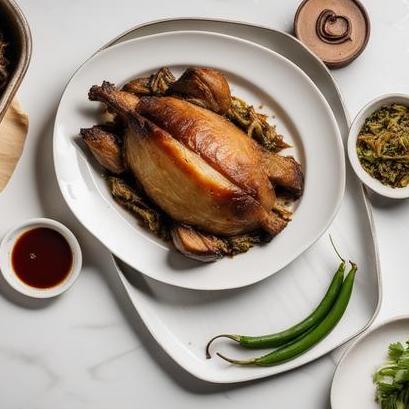
Mojo-Marinated Pernil
For a twist on the traditional pernil recipe, consider infusing the meat with a tangy mojo marinade. Mojo is a vibrant sauce made with sour orange juice, garlic, olive oil, and spices. This variation adds a zesty and refreshing flavor to the pernil, making it a perfect choice for those who prefer a tangier taste.
Adobo Pernil
If you’re a fan of bolder flavors, try an adobo-inspired pernil. Adobo seasoning, a mixture of garlic, oregano, cumin, and salt, provides a robust, savory taste that complements the richness of the pork shoulder. This variation adds a delightful complexity to the dish that is sure to impress your guests.
Herb-Crusted Pernil
For herb enthusiasts, an herb-crusted pernil is a fantastic choice. Create a paste using fresh herbs such as rosemary, thyme, sage, and parsley, along with garlic and olive oil. Smear this herbaceous mixture generously over the pork shoulder before cooking to infuse the meat with aromatic flavors and create a fragrant crust.
Checking for Doneness
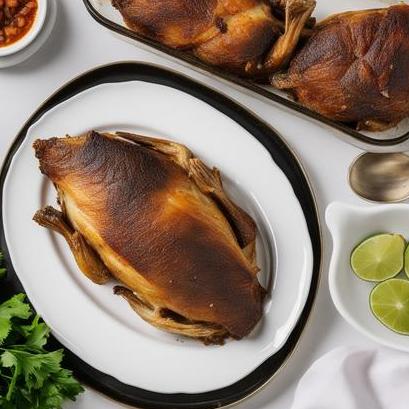
Using a Meat Thermometer
To ensure your pernil is perfectly cooked, it’s essential to check its internal temperature. Use a meat thermometer inserted into the thickest part of the pork shoulder, without touching the bone. The desired temperature should reach 190°F (88°C) for a tender, fall-off-the-bone texture.
Texture Test
Another way to check for doneness is by examining the texture. Gently tug at the meat with a fork or tongs. If it separates easily into soft, moist shreds, the pernil is ready to be devoured. However, if it resists or feels tough, continue cooking until the desired tenderness is achieved.
Potential Pitfalls: Overcooking and Undercooking
Overcooking
Overcooking the pernil can result in a dry and tough roast. To prevent this, monitor the internal temperature regularly and avoid exceeding 190°F (88°C). As mentioned earlier, basting the roast throughout the cooking process will help maintain moisture and prevent drying.
Undercooking
Undercooking the pork shoulder can lead to potentially unsafe consumption. To avoid this, ensure the internal temperature reaches a minimum of 145°F (63°C). However, for pernil, it’s best to aim for the recommended 190°F (88°C) for optimum tenderness.
Pernil Oven Recipe
Ingredients:
-
1 bone-in, skin-on pork shoulder (5-7 pounds)
-
1 cup orange juice
-
1/2 cup lime juice
-
8 cloves of garlic, minced
-
2 tablespoons dried oregano
-
2 teaspoons cumin
-
2 tablespoons adobo seasoning
-
Salt and pepper to taste
Instructions:
-
Rinse the pork shoulder under cold running water and pat dry with paper towels.
-
Score the skin in a crisscross pattern, approximately 1 inch apart.
-
In a bowl, combine the orange juice, lime juice, minced garlic, oregano, cumin, adobo seasoning, salt, and pepper.
-
Place the pork shoulder in a large, resealable bag and pour the marinade over it.
-
Massage the marinade into the meat, ensuring all sides are coated.
-
Seal the bag tightly and refrigerate for at least 24 hours.
-
Preheat the oven to 325°F (165°C).
-
Place the marinated pork shoulder, along with the marinade, in a large roasting pan or Dutch oven.
-
Cover tightly with a lid or aluminum foil.
-
Cook the pernil in the preheated oven for approximately 3 to 4 hours, or until the internal temperature reaches 190°F (88°C).
-
Every hour, uncover the pan and baste the pernil with its own juices.
-
About 30 minutes before the cooking time is complete, increase the oven temperature to 425°F (218°C) to ensure a crispy skin.
-
Once cooked, remove the pernil from the oven, tent it loosely with foil, and let it rest for 20 minutes.
-
Carve and serve the pernil, basking in the delicious aromas and flavors.
Conclusion
In this extensive guide, we’ve explored the world of pernil, from the food science behind its succulence to selecting the perfect pork shoulder, cleaning, preparation, cooking tips, variations, and even addressing potential pitfalls. Armed with this comprehensive knowledge, you’re equipped to embark on your pernil-making journey. So set your oven to preheat, gather the ingredients, and get ready to savor the sheer delight of a perfectly cooked, mouthwatering pernil.
Sources
FAQS On Pernil Oven Recipe
What Is Pernil?
Pernil is a traditional Puerto Rican dish made from roast pork shoulder. It is typically marinated in a flavorful blend of herbs and spices, then slow-cooked in the oven until tender and juicy.
What Ingredients Do I Need For A Pernil Oven Recipe?
To make pernil in the oven, you will need a bone-in pork shoulder (around 4-5 pounds), garlic cloves, dried oregano, ground cumin, paprika, salt, black pepper, olive oil, orange juice, and lime juice. You may also choose to add additional spices or herbs based on personal preference.
How Do I Marinate The Pernil?
To marinate the pernil, start by making a paste with minced garlic, dried oregano, ground cumin, paprika, salt, black pepper, and olive oil. Rub this mixture all over the pork shoulder, ensuring it is evenly coated. Then, place the pork in a large resealable bag or a covered dish and let it marinate in the refrigerator for at least 6-8 hours, or ideally overnight.
How Do I Cook Pernil In The Oven?
Preheat your oven to 325°F (165°C). Remove the marinated pork shoulder from the refrigerator and let it come to room temperature for about 30 minutes. Place the pork in a roasting pan and pour the marinade over the meat. Cover the pan tightly with foil and bake for approximately 4-5 hours, or until the internal temperature reaches 190°F (88°C) and the meat is tender and falling apart. Periodically baste the meat with the pan juices to ensure it remains moist.
How Do I Achieve A Crispy Skin On The Pernil?
If you desire a crispy skin on the pernil, you can uncover the roasting pan during the last 30 minutes of cooking. Increase the oven temperature to 450°F (230°C) and allow the skin to brown and crisp up. Keep a close eye on the pork during this time to prevent burning. Once the skin is crispy, remove from the oven and let the pernil rest for about 15 minutes before carving and serving.



